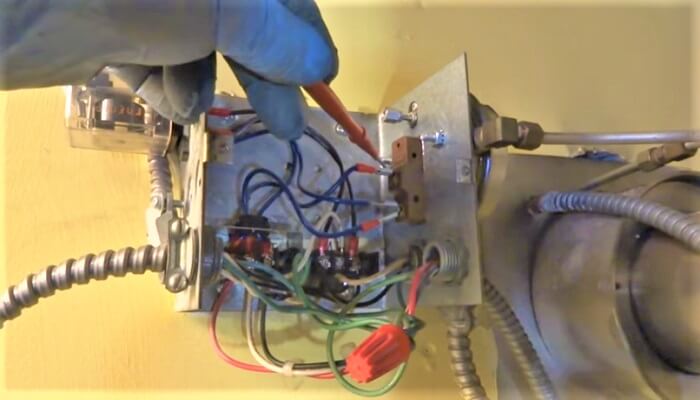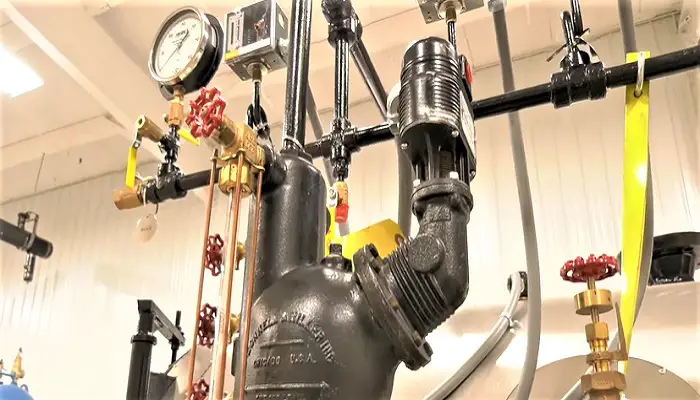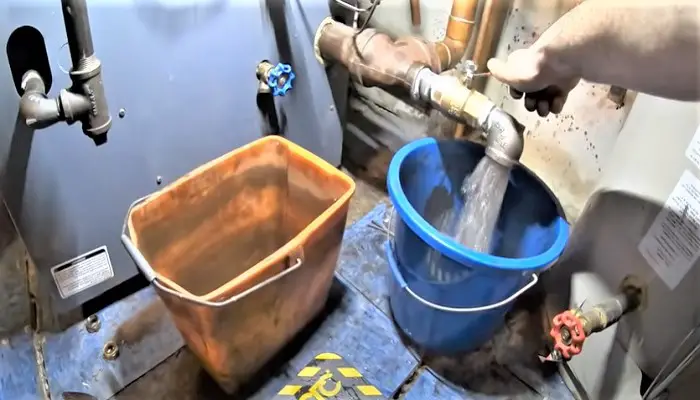| Note: This article may contain affiliate links, which means if you make a purchase following our links won’t cost you extra, but we may earn a commission. Learn more |
Steam boilers are a type of boiler that uses steam to create heat. The heated steam is then used to produce mechanical or electrical power. Steam boilers have been in use for centuries, and are still an important part of the world’s energy infrastructure.
There are many different types of steam boilers, but all share some common features. All steam boilers require a source of heat to produce the steam, and most use water as the working fluid. In addition, all steam boilers must be equipped with a means of conveying the heated water or steam from the furnace to where it can be used to generate power or heat buildings or other processes.
The steam boiler is used to provide heat for a variety of process applications, such as heating and drying, food processing, and pulp and paper production.
The steam boiler may be fire-tube or water-tube, horizontal or vertical, internal or external combustion, and either once-through or natural circulation. The steam boiler consists of a furnace, where fuel is burned, and a heat exchanger, where the heat from the burning fuel is transferred to the water. The steam boiler can be powered by a variety of fuels, including natural gas, propane, oil, and biomass.
But you sometimes notice a change in this total process, be it over time or due to the inefficiency of one or more parts of the boiler. Whatever the case, the results don’t come in your favor, you just get bored. Let’s discuss some of the problems you may be having with your boiler and how to fix them.
1. Steam Boiler Not Turning on
If your steam boiler is not turning on, the most common reason is that the boiler is not getting enough power. This can be caused by a number of things, including a tripped circuit breaker or a blown fuse. If you have checked the power and it seems to be working, another possibility is that the pilot light is out. This can be relit by following the instructions in your boiler’s manual.
If the pilot light is lit but the boiler still won’t turn on, there may be a problem with the thermostat. This can be checked by opening the boiler’s access panel and making sure that the thermostat is set to the correct position. If it is, then you may need to call a professional to come and take a look at your boiler.
Another possibility is that there is something blocking the flow of water into the boiler. This can be caused by a build-up of limescale or sediment in the pipes. If this is the case, you will need to flush out the pipes to clear the blockage.
There may be other reasons for this It may be that there is no fuel or water in the system, the burner may be dirty or blocked, the thermostat may be set incorrectly, or there could be a problem with the ignition system.
If you are experiencing this issue, it is best to call a professional to help diagnose and fix the problem.

2. Steam Boiler Low Water Cut-Off Problems
If your steam boiler’s low water cut-off switch is tripping, the most common reason is simply that the boiler’s water level is too low. There may be some reasons for this-
– The boiler’s water level is too low.
– There is a leak in the boiler or in one of the pipes leading to or from the boiler.
– The boiler’s feed water valve is not open or is only partially open.
– The boiler’s circulating pump is not working properly or is turned off.
– The boiler’s low water cut-off switch is set too low.
If the boiler’s water level is too low, the first thing you should do is check for leaks. If there are no leaks, then check the feed water valve and the circulating pump. If they are both working properly, then you may need to adjust the low water cut-off switch.
A low water cut-off (LWCO) is a safety device used on steam boilers. When the water level in the boiler falls below a certain point, the LWCO shuts down the boiler. This prevents the boiler from running out of water and potentially exploding.
The LWCO is usually set to shut down the boiler when the water level falls below 30% of capacity. This allows time for someone to add more water to the boiler before it runs out completely. The LWCO can also be set to shut down at different levels, depending on your needs.
It is important to have a low water cut-off installed on your steam boiler, especially if you are not able to monitor it constantly. A properly functioning LWCO can help prevent accidents and save lives.
3. Steam Boiler Not Heating All Radiators
If your steam boiler is not heating all radiators, the possibility is that the boiler is not big enough to heat all the radiators or there is something blocking the flow of steam to one or more of the radiators. It is also possible that the radiator itself is not working properly.
If you think that the boiler is not big enough to heat all the radiators, the best thing to do is to get a bigger boiler. If you are unsure how to do this, you can ask a plumber or a heating contractor.
If you think that there is something blocking the flow of steam to one or more of the radiators, the best thing to do is to check the radiators and see if there is anything blocking the steam vents. If there is, you can try to remove the obstruction.
If the radiator itself is not working properly, the best thing to do is to call a heating contractor and have them come and take a look at it. They will be able to tell you if the radiator needs to be replaced or if there is something else that needs to be done.
A steam boiler not heating all radiators may be the result of low water pressure. If the pressure is below 12 psi, then some of the radiators will not get hot. The fix for this is to increase the water pressure or to bleed some air from the system.
4. Steam Boiler Not Building Pressure
A steam boiler, not building pressure may be the result of a variety of problems. The first step in troubleshooting is to identify the specific problem. Some common causes of low pressure are a dirty or blocked burner, low water level, or a leak in the system.
If it is determined that the burner is dirty or blocked, it should be cleaned and/or serviced. If the water level is low, adding more water should correct the problem. If there is a leak in the system, then it will need to be repaired before pressure can build correctly.
Once any potential problems have been identified and corrected, if necessary, then check to make sure that all valves are open and that there are no restrictions on either the supply or return lines. Also, check for any leaks around fittings or joints as these could also prevent proper pressure from being achieved.
If the water level is too low, the boiler will not be able to build enough pressure to create steam. You can check the water level in the boiler by looking at the sight glass on the side of the boiler. If the water level is too low, you will need to add more water to the boiler.
If the boiler is not able to build pressure, it may be because there is a leak in the boiler. You can check for leaks by looking at the pressure gauge on the front of the boiler. If the pressure gauge is reading lower than it should, there is likely a leak in the boiler.
If there is a leak in the boiler, you will need to call a professional to come and fix the problem. You should not try to fix a leak in the boiler yourself, as this can be very dangerous.
If the boiler is not building pressure, it may be because the pilot light is not lit. If the pilot light is not lit, the boiler will not be able to build pressure. You can check the pilot light by looking at the control panel on the front of the boiler. If the pilot light is not lit, you will need to call a professional to come and fix the problem.

5. Steam Boiler Keeps Filling With Water
A common problem with steam boilers is that they can fill up with too much water, which can cause the boiler to malfunction or even explode.
There are several possible causes of a boiler filling up with too much water. If there’s something wrong with the valves or piping leading to the boiler, which may be allowing too much water in from either the feedwater tank or from another part of the system. It’s also possible that there’s something wrong with the way the boiler itself is functioning, such as a leaky valve or cracked pipe.
If your steam boiler keeps filling up with water, it could be due to one of four possible causes. The first possibility is that the water level in the boiler is too high. This can be caused by a variety of factors, including a leak in the system or a problem with the float valve that regulates the water level. If the water level is too high, it can cause the boiler to overheat and eventually break down.
The boiler’s pressure relief valve is designed to release pressure if the boiler gets too hot, but if it is not working properly, it can cause the boiler to fill up with water. It’s also a possibility that the boiler’s condensate return system is not working properly. This system is responsible for returning water that has condensed back into the boiler, but if it is not working properly, it can cause the boiler to fill up with water.
If you think your steam boiler is filling up with water due to one of these possible causes, you should contact a qualified boiler technician to diagnose and repair the problem.

6. Steam Boiler Leaking Water From the Bottom
Another problem with a steam boiler is that it can leak water from the bottom.
There are several reasons why a boiler might leak water from the bottom. One possibility is that there is something blocking the drainage hole at the bottom of the boiler. This could be caused by sediment or scale buildup, or by something else getting caught in the hole such as a piece of metal or plastic. If this is the case, then removing whatever is blocking the hole should stop the leaks.
Another possible cause of leaks from a steam boiler is damage to its internal components. This might happen if there was some sort of explosion inside the boiler, or if it was hit by something hard like a rock or bullet fragment. In these cases, repairing or replacing damaged components will usually fix the problem. Other reasons-
1. Pressure: If your steam boiler pressure is too high, it can cause your boiler to leak water. To fix this, you’ll need to adjust the pressure relief valve.
2. Temperature: If the water in your boiler is too hot, it can cause the boiler to leak. To fix this, you should adjust the thermostat.
3. Corrosion: Over time, the water in your boiler can become corrosive. This can cause your boiler to leak. To fix this, you’ll need to add a corrosion inhibitor to the water.
4. Sediment: Over time, the water in your boiler can become filled with sediment. This can cause your boiler to leak. To fix this, you’ll need to flush the boiler.
5. Leaks: If your boiler is leaking, it’s likely because there is a hole or crack in the boiler. To fix this, you’ll need to patch or replace the boiler.
